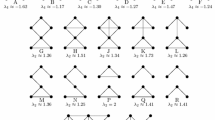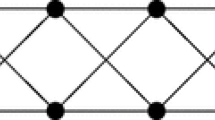Abstract
In this paper, we completely characterize the graphs with third largest distance eigenvalue at most \(-1\) and smallest distance eigenvalue at least \(-3\). In particular, we determine all graphs whose distance matrices have exactly two eigenvalues (counting multiplicity) different from \(-1\) and \(-3\). It turns out that such graphs consist of three infinite classes, and all of them are determined by their distance spectra. We also show that the friendship graph is determined by its distance spectrum.

Similar content being viewed by others
References
Abdollahi, A., Janbaz, S., Oboudi, M.R.: Graphs cospectral with a friendship graph or its complement. Trans. Comb. 2, 37–52 (2013)
Cioabǎ, S.M., Haemers, W.H., Vermette, J.R., Wong, W.: The graphs with all but two eigenvalues equal to \(\pm \)1. J. Algebraic Comb. 41, 887–897 (2015)
Cvetković, D., Rowlinson, P., Simić, S.: An Introduction to the Theory of Graph Spectra. Cambrige University Press, New York (2010)
Das, K.C.: Proof of conjectures on adjacency eigenvalues of graphs. Discret. Math. 313, 19–25 (2013)
Günthard, H.H., Primas, H.: Zusammenhang von graphentheorie und MO-theorie von molekeln mit systemen konjugierter bindungen. Helv. Chim. Acta 39, 1645–1653 (1956)
Jin, Y.L., Zhang, X.D.: Complete multipartite graphs are determined by their distance spectra. Linear Algebra Appl. 448, 285–291 (2014)
Lin, H., Zhai, M.Q., Gong, S.C.: On graphs with at least three ditance eigenvalues less than \(-1\). Linear Algebra Appl. 458, 548–558 (2014)
Seinsche, D.: On a property of the class of \(n\)-colorable graphs. J. Comb. Theory Ser. B 16, 191–193 (1974)
van Dam, E.R., Haemers, W.H.: Which graphs are determined by their spectrum? Linear Algebra Appl. 373, 241–272 (2003)
van Dam, E.R., Haemers, W.H.: Developments on spectral characterizations of graphs. Discret. Math. 309, 576–586 (2009)
Wang, J.F., Belardo, F., Huang, Q.X., Borovicanin, B.: On the two largest \(Q\)-eigenvalues of graphs. Discret. Math. 310, 2858–2866 (2010)
Yu, G.L.: On the least distance eigenvalue of a graph. Linear Algebra Appl. 439, 2428–2433 (2013)
Acknowledgments
The authors are grateful to the referees for their helpful comments and suggestions that have improved our results in this paper.
Author information
Authors and Affiliations
Corresponding author
Additional information
Supported by the National Natural Science Foundation of China (11671344, 11261059, 11531011).
Appendix: Spectra of graphs in \({\mathcal {G}}[-3\le \partial _n,\partial _3\le -1]\)
Appendix: Spectra of graphs in \({\mathcal {G}}[-3\le \partial _n,\partial _3\le -1]\)
Graphs | Distance Spectra | f(x) |
|---|---|---|
\(S(0,1)=K_1\vee (K_5\cup K_1)\) | \([7.66,-0.71,(-1)^4,-2.96]\) | – |
\(S(1,0)=K_2\vee (K_5\cup K_1)\) | \([8.47,-0.47,(-1)^5,-3]\) | – |
\(S(m,n)=(K_5\cup K_1)\vee (mK_2\cup nK_1)\,(m,n\ne 0)\) | \([\partial _1,\partial _2,(-1)^{m+4},(-2)^{n-1},\partial _3,(-3)^m]\) | [\(x^3-(2n+4m+2)x^2+(2n+8m-28)x+(32m+24n-40)\)] |
\(S(m,0)=(K_5\cup K_1)\vee mK_2\,(m\ge 2)\) | \([\partial _1,\partial _2,(-1)^{m+4},(-3)^m]\) | [\(-x^2+(4m+4)x+20-16m\)] |
\(S(0,n)=(K_5\cup K_1)\vee nK_1\,(n\ge 2)\) | \([\partial _1,\partial _2,(-1)^4,\partial _3,(-2)^{n-1}]\) | [\(x^3-(2n+2)x^2+(2n-28)x+(24n-40)\)] |
\(K_r\vee T_1=K_r\vee (K_4\cup K_1)\) | \([\partial _1,\partial _2,(-1)^{r+2},\partial _3](\partial _3>-3)\) | [\(x^3-(r+2)x^2-(2r+19)x+(3r-16)\)] |
\(K_r\vee T_2=K_r\vee (K_3\cup 2K_1)\) | \([\partial _1,\partial _2,(-1)^{r+1},-2,\partial _3](\partial _3>-3)\) | [\(x^3-(r+3)x^2-(r+24)x+(6r-20)\)] |
\(K_r\vee T_3=K_r\vee (K_3\cup K_1)\) | \([\partial _1,\partial _2,(-1)^{r+1},\partial _3](\partial _3>-3)\) | [\(x^3-(r+1)x^2-(2r+14)x+(2r-12)\)] |
\(K_r\vee T_4(m,n)=K_r\vee (mK_2\cup nK_1)\,(n,m\ne 0)\) | \([\partial _1,\partial _2,(-1)^{m+r-1},(-2)^{n-1},\partial _3,(-3)^{m-1}]\) | [\(x^3+(6-2n-4m-r)x^2+(2mr-8n-5r-12m+nr+11)x-(8m+6n+6r-4mr-3nr-6)\)] |
\(K_r\vee T_4(m,0)=K_r\vee mK_2\,(m\ge 2)\) | \([\partial _1,\partial _2,(-1)^{m+r-1},(-3)^{m-1}]\) | [\(x^2+(4-r-4m)x+(2mr-4m-3r+3)\)] |
\(K_r\vee T_4(0,n)=K_r\vee nK_1\,(n\ge 2)\) | \([\partial _1,\partial _2,(-1)^{r-1},(-2)^{n-1}]\) | [\(x^2+(3-r-2n)x+(nr-2n-2r+2)\)] |
\(T_1\vee T_1=(K_4\cup K_1)\vee (K_4\cup K_1)\) | \([10.71,1,(-1)^6,-2.71,-3]\) | – |
\(T_1\vee T_2=(K_4\cup K_1)\vee (K_3\cup 2K_1)\) | \([11.32,1.46,(-1)^5,-2,-2.78,-3]\) | – |
\(T_1\vee T_3=(K_4\cup K_1)\vee (K_3\cup K_1)\) | \([9.65,0.85,(-1)^5,-2.6,-2.9]\) | – |
\(T_1\vee T_4(m,n)=(K_4\cup K_1)\vee (mK_2\cup nK_1)\,(m,n\ne 0)\) | \([\partial _1,\partial _2,(-1)^{m+3},(-2)^{n-1},\partial _3,\partial _4,(-3)^{m-1}]\) | [\(x^4+(2-2n-4m)x^3-(6m+5n+25)x^2+(42m+22n-98)x+76m+57n-96\)] |
\(T_1\vee T_4(m,0)=(K_4\cup K_1)\vee mK_2\,(m\ge 2)\) | \([\partial _1,\partial _2,(-1)^{m+3},\partial _3,(-3)^{m-1}]\) | [\(x^3-4mx^2+(2m-25)x+38m-48\)] |
\(T_1\vee T_4(0,n)=(K_4\cup K_1)\vee nK_1\,(n\ge 2)\) | \([\partial _1,\partial _2,(-1)^3,(-2)^{n-1},\partial _3](\partial _3>-3)\) | [\(x^3-(2n+1)x^2+(n-22)x+19n-32\)] |
\(T_2\vee T_2=(K_3\cup 2K_1)\vee (K_3\cup 2K_1)\) | \([11.87,2,(-1)^4,(-2)^2,-2.87,-3]\) | – |
\(T_2\vee T_3=(K_3\cup 2K_1)\vee (K_3\cup K_1)\) | \([10.34,1.25,(-1)^4,-2,-2.63,-2.95]\) | – |
\(T_2\vee T_4(m,n)=(K_3\cup 2K_1)\vee (mK_2\cup nK_1)\,(m,n\ne 0\)) | \([\partial _1,\partial _2,(-1)^{m+2},(-2)^n,\partial _3,\partial _4,(-3)^{m-1}]\) | [\(x^4+(1-2n-4m)x^3-(2m+3n+34)x^2+(64m+35n-124)x+104m+78n-120\)] |
\(T_2\vee T_4(m,0)=(K_3\cup 2K_1)\vee mK_2\,(m\ge 2)\) | \([\partial _1,\partial _2,(-1)^{m+2},-2,\partial _3,(-3)^{m-1}]\) | [\(x^3-(4m+1)x^2+(6m-32)x+52m-60\)] |
\(T_2\vee T_4(0,n)=(K_3\cup 2K_1)\vee nK_1\,(n\ge 2)\) | \([\partial _1,\partial _2,(-1)^2,(-2)^n,\partial _3](\partial _3>-3)\) | [\(x^3-(2n+2)x^2+(3n-28)x+26n-40\)] |
\(T_3\vee T_3=(K_3\cup K_1)\vee (K_3\cup K_1)\) | \([8.57,0.73,(-1)^4,-2.57,-2.73]\) | – |
\(T_3\vee T_4(m,n)=(K_3\cup K_1)\vee (mK_2\cup nK_1)\,(m,n\ne 0)\) | \([\partial _1,\partial _2,(-1)^{m+2},(-2)^{n-1},\partial _3,\partial _4,(-3)^{m-1}]\) | [\(x^4+(3-2n-4m)x^3-(8m+6n+16)x^2+(28m+14n-72)x+56m+42n-72\)] |
\(T_3\vee T_4(m,0)=(K_3\cup K_1)\vee mK_2\,(m\ge 2)\) | \([\partial _1,\partial _2,(-1)^{m+2},\partial _3,(-3)^{m-1}]\) | [\(x^3-(4m-1)x^2-18x+28m-36\)] |
\(T_3\vee T_4(0,n)=(K_3\cup K_1)\vee nK_1\,(n\ge 2)\) | \([\partial _1,\partial _2,(-1)^2,(-2)^{n-1},\partial _3](\partial _3>-3)\) | [\(x^3-2nx^2-16x+14n-24\)] |
\(T_4(m_1,n_1)\vee T_4(m_2,n_2)=(m_1K_2\cup n_1K_1)\vee (m_2K_2\cup n_2K_1)(m_1,m_2,n_1,n_2\ne 0\)) | \([\partial _1,\partial _2,(-1)^{m_1+m_2},(-2)^{n_1+n_2-2},\partial _3,\partial _4,(-3)^{m_1+m_2-2}]\) | [\(x^4+(10-4(m_1+m_2)-2(n_1+n_2))x^3+(12m_1m_2-28(m_1+m_2)-16(n_1+n_2) +6(m_1n_2+m_2n_1)+37)x^2+(48m_1m_2-64(m_1+m_2)-42(n_1+n_2)+30(m_1n_2+m_2n_1)+18n_1n_2+60)x -(48(m_1+m_2-m_1m_2)+36(n_1+n_2)-36(m_1n_2+m_2n_1)-27n_1n_2+36)\)] |
\(T_4(m_1,n_1)\vee T_4(m_2,0)=(m_1K_2\cup n_1K_1)\vee m_2K_2 (m_1,n_1\ne 0,m_2\ge 2)\) | \([\partial _1,\partial _2,(-1)^{m_1+m_2},(-2)^{n_1-1},\partial _3,(-3)^{m_1+m_2-2}]\) | [\(x^3+(8-4(m_1+m_2)-2n_1)x^2+(12m_1m_2-20(m_1+m_2)-12n_1+6m_2n_1+21)x -24(m_1+m_2)+18m_2n_1+24m_1m_2-18n_1+18\)] |
\(T_4(m_1,n_1)\vee T_4(0,n_2)=(m_1K_2\cup n_1K_1)\vee n_2K_1 (m_1,n_1\ne 0,n_2\ge 2)\) | \([\partial _1,\partial _2,(-1)^{m_1},(-2)^{n_1+n_2-2},\partial _3,(-3)^{m_1-1}]\) | [\(x^3+(7-2(n_1+n_2)-4m_1)x^2+(6m_1n_2-10(n_1+n_2)-16m_1+3n_1n_2+16)x-12(n_1+n_2)+12m_1n_2+9n_1n_2-16m_1+12\)] |
\(T_4(m_1,0)\vee T_4(m_2,0)=m_1K_2\vee m_2K_2\,(m_1,m_2\ge 2)\) | \([\partial _1,\partial _2,(-1)^{m_1+m_2},(-3)^{m_1+m_2-2}]\) | \([x^2+(6-4(m_1+m_2))x-12(m_1+m_2)+12m_1m_2+9]\) |
\(T_4(m_1,0)\vee T_4(0,n_2)=m_1K_2\vee n_2K_1\,(m_1,n_2\ge 2)\) | \([\partial _1,\partial _2,(-1)^{m_1},(-2)^{n_2-1},(-3)^{m_1-1}]\) | \([x^2+(6-4(m_1+m_2))x-12(m_1+m_2)+12m_1m_2+9]\) |
\(T_4(0,n_1)\vee T_4(0,n_2)=n_1K_2\vee n_2K_1\,(n_1,n_2\ge 2)\) | \([\partial _1,\partial _2,(-2)^{n_1+n_2-2}]\) | \([x^2+(4-2(n_1+n_2))x-4(n_1+n_2)+3n_1n_2+4]\) |
Rights and permissions
About this article
Cite this article
Lu, L., Huang, Q. & Huang, X. The graphs with exactly two distance eigenvalues different from \(-1\) and \(-3\) . J Algebr Comb 45, 629–647 (2017). https://doi.org/10.1007/s10801-016-0718-2
Received:
Accepted:
Published:
Issue Date:
DOI: https://doi.org/10.1007/s10801-016-0718-2




